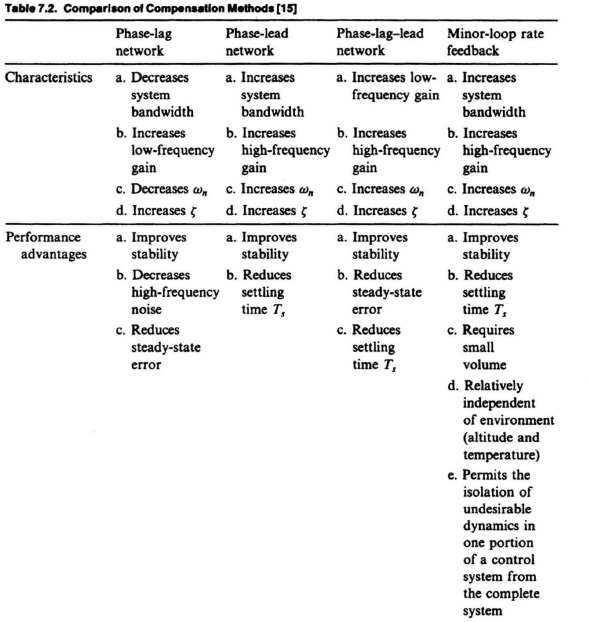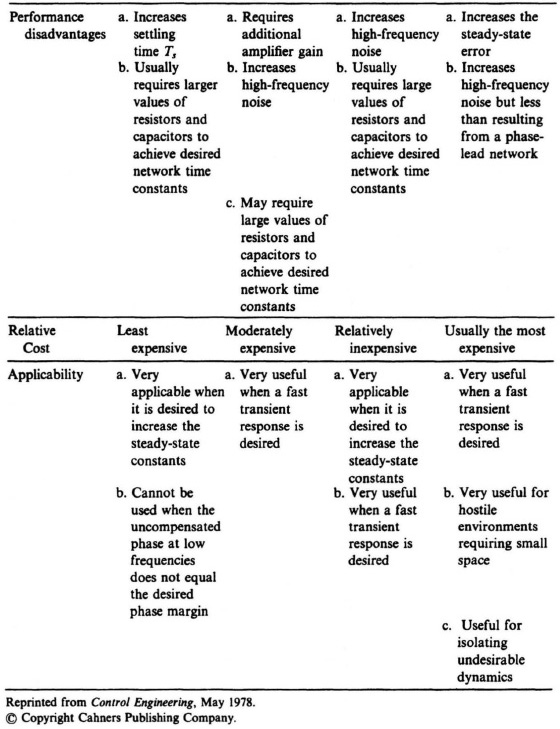7.10. TRADEOFFS OF USING VARIOUS CASCADE-COMPENSATION METHODS AND MINOR-LOOP FEEDBACK
This chapter has presented the use of phase-lag, phase-lead, and phase-lag–lead cascade compensation networks, and minor-loop feedback, compensation (such as rate feedback). The question arises as to which compensation method should be used: cascade compensation or minor-loop feedback compensation. If the answer turns out to be cascade compensation, the question arises as to whether we should use phase-lag, phase-lead, or phase-lag–lead networks? This section addresses these reasonable questions by discussing the tradeoffs of these different methods of compensation, and guidelines are provided for the practical design of control systems.
I cannot provide a simple answer as to what compensation approach is the “best” method to use. Table 7.2 [11] compares the advantages and disadvantages of phase-lag, phase-lead, and phase-lag–lead networks, and minor-loop rate feedback for compensation. They are compared on the basis of characteristics, performance, applicability, and relative cost. Each of these four approaches will improve system stability if used properly, as shown in Chapters 6 and 7. Therefore, each system must be considered separately in order to determine the most effective, optimimum, or “best” approach.
If the system specification requires the need for a low-noise (“quiet”) control system having a small steady-state error, then the phase-lag–network approach is the most desirable from the viewpoints of performance and cost. The phase-lead network is desirable for systems requiring a very fast response, and if the resulting increase in high-frequency noise is tolerable. The phase-lag–lead network has essentially the advantages in performance of both the phase-lag and phase-lead networks. It can result in control systems which are very fast, on a relative basis, and they can result in very small steady-state errors.
Minor-loop feedback compensation using rate-feedback from tachometers and rate gyros has the advantage that it results in a pure zero, when connected in parallel with the position feedback, and represents ideal compensation. Rate-compensating devices have the additional advantage of only requiring a small volume and they are relatively independent of the environmental conditions in which they are operating such as temperature, humidity, and altitude. This is advantageous for control systems operating in space vehicles, airplanes, and ships. For example, if a phase-lead network were used in a hostile environment, the possible use of very large resistors and capacitors could result in very large time-constant variations causing a stable control system to behave as a conditionally stable control system.
In trading off the advantages and disadvantages of minor-loop feedback compensation, it should be emphasized that although they result in systems having the highest performance, this approach is usually also the most expensive. However, in some cases, it may be the only and “best” way to go.
In the practical world of control-system applications, each case is not so straight-forward that the control-system engineer can merely go to Table 7.2 and choose an approach clearly. Conflicting system requirements will usually direct the control-system engineer to more than one possible solution, and neither one of them may be the “best” method. In the final design, the choice of the compensating approach will usually be a compromise based on the tradeoffs considered.
The control-system engineer will usually select the approach based on his or her experience, subjective personal preferences, and the availability of components. As was discussed in the case of choosing the “best” method for stability analysis in Section 6.22, all of the compensation methods should be considered before one is selected. Then the “best” or most effective technique can be selected by the control-system engineer for the final design.


